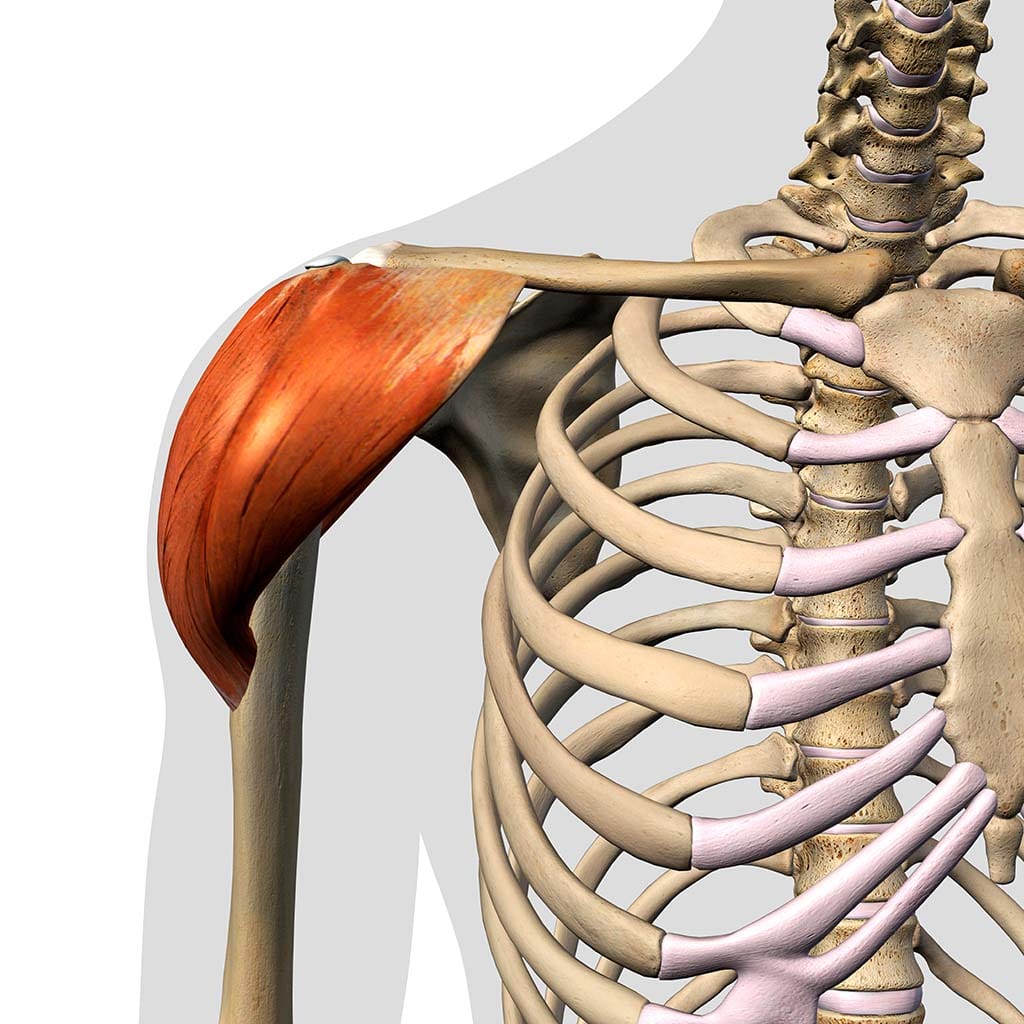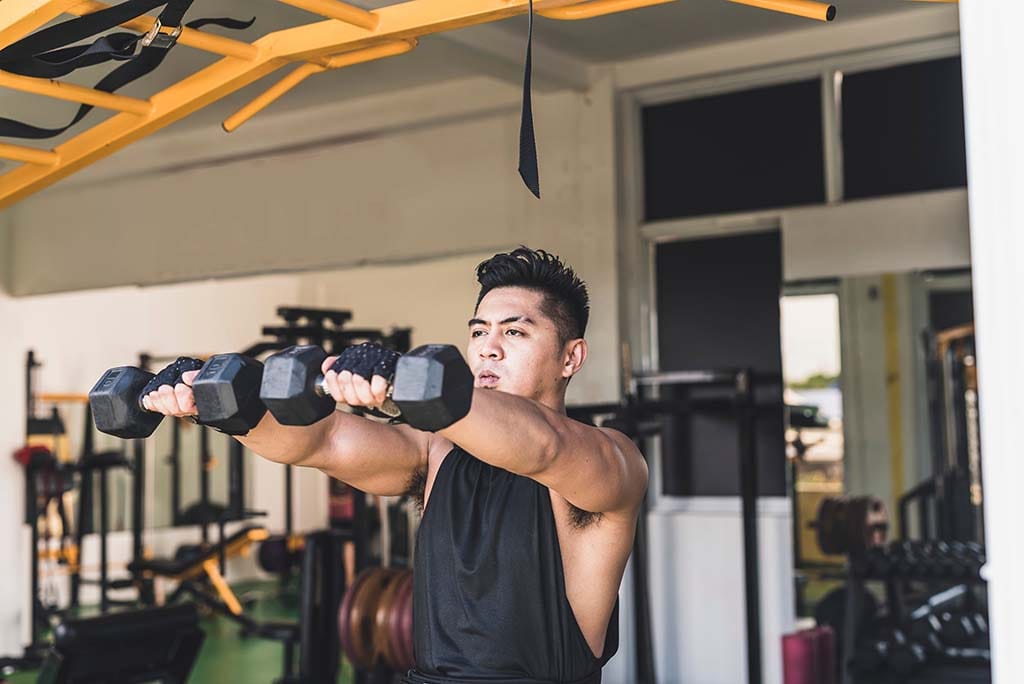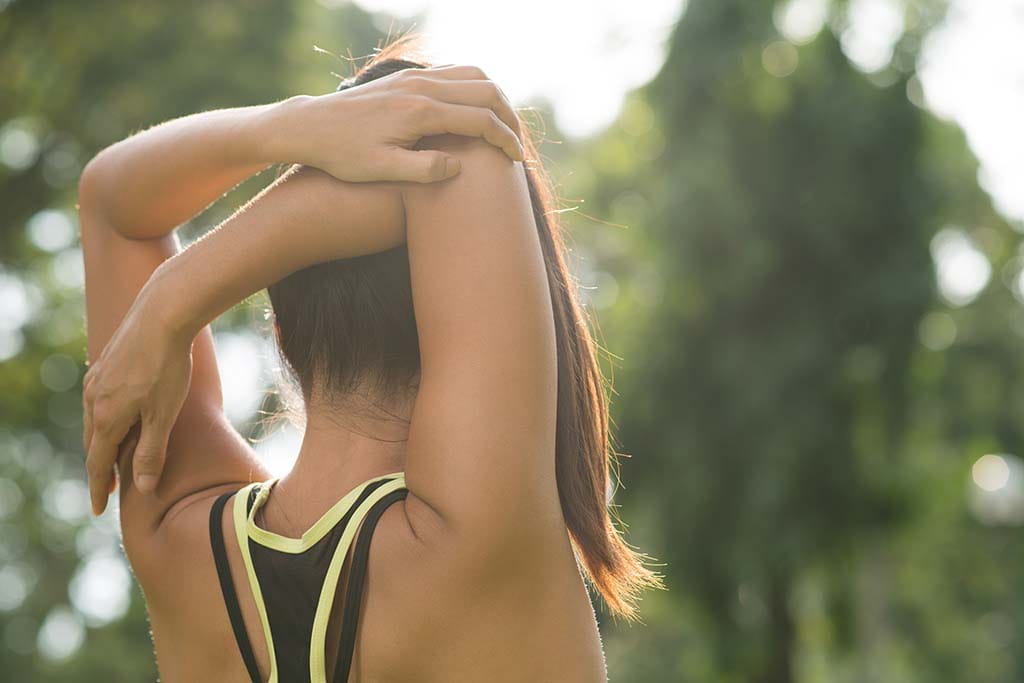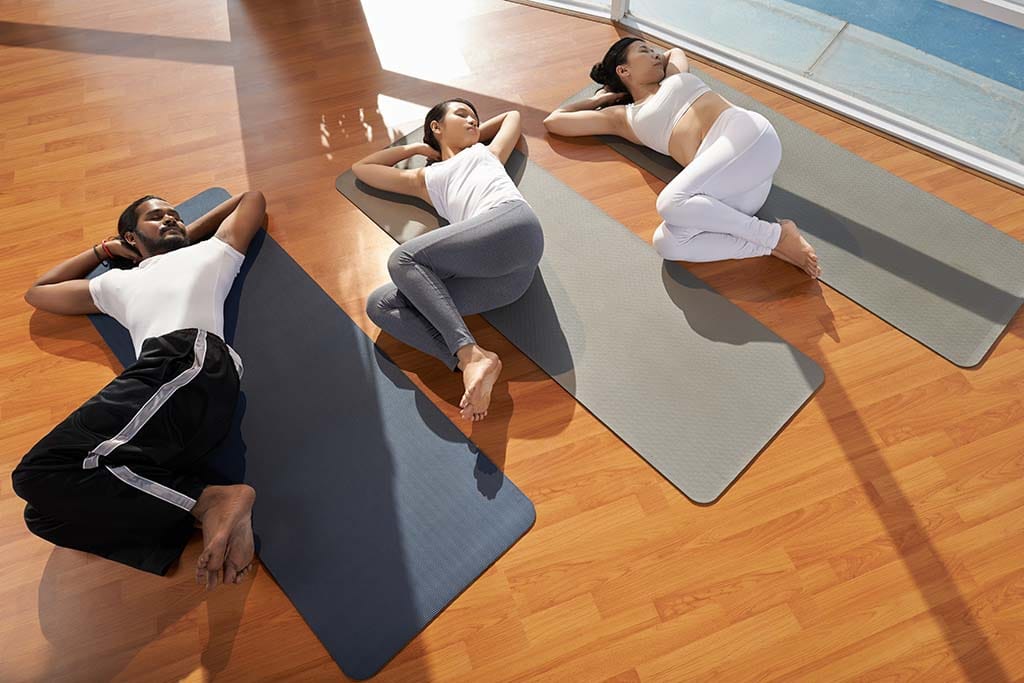3D Shoulders: Develop Your Deltoids’ Strength & Shape
Fit shoulders are not only functionally strong, but they can also be a great asset to the aesthetic balance of your upper body.
If you’re into aesthetic workouts and want a better-looking physique, enhancing the look of your shoulders is a key consideration. That’s when you may hear the word 3d shoulders.
A quick Google search will show you hundreds of images of 3D shoulders. This look is mostly comprised of bulging deltoid muscles, with even muscle development, creating a rounded appearance.
This simple guide to 3D shoulders will give you the best moves for well-honed deltoids. We’ll walk you through the steps of simple exercises you can do to grow your deltoids and explain how to work these moves into your weekly workout plan.
We’ll also examine how you can incorporate targeted shoulder growth into the rest of your workouts for even more muscle development that prioritizes an aesthetic figure.
So, take your time and continue reading this article.
What Are 3D Shoulders?
Of course, all shoulders are technically 3D since we exist in the physical realm (duh), but 3D shoulders almost take your upper body one dimension above and beyond.
3D shoulder refers to well-developed muscles that give you a rounded, three-dimensional appearance. Typically, the main shoulder muscles responsible for this look are your deltoids (also known as “delts”).
You typically achieve this look by targeting all three heads of the deltoid muscle. Here’s a quick deltoid muscle anatomy breakdown to help you understand the location and function of each muscle in this group.
Anterior Deltoid (Front)

Your front deltoids, or “anterior deltoids,” are responsible for flexing your shoulders. That involves raising your arms forward.
Front delts play a key role in pushing movements, such as bench presses and overhead presses. They also assist in internal rotation and adduction of your arms.
Exercises like front raises and overhead presses target this part of the shoulder, contributing to the forward roundness. Read more about front delt workouts to build up these muscles and achieve the look of 3D shoulders.
Lateral Deltoid (Side)
Your side deltoids, or lateral deltoids, are responsible for shoulder abduction, aka raising your arms out to the side.
Any workout you do where you lift your arms away from your body (like lateral raises) works your side delts. These muscles also help stabilize your shoulder joints during upper-body workouts.
If you struggle with narrow clavicles or sloped shoulders, there’s a chance you’re not properly developing your side delts. Lateral raises and upright rows will hit the side delts, adding width and a more pronounced side profile.
Posterior Deltoid (Rear)
Rear deltoid flies and face pulls engage the rear delts, enhancing the back part of the shoulder and overall shoulder depth.
Training all three heads of the deltoid ensures balanced development, leading to the desired "3D" effect. This balanced approach not only improves aesthetics but also enhances shoulder strength and stability.
What Are the Benefits of 3D Shoulder Exercises?
What’s more, 3D shoulders come with a few key benefits:
- Shoulder Health: The shoulder joint, also called the glenohumeral joint, is one of the most mobile joints in the human body. This makes it wonderful for your mobility if worked efficiently, but also easy to injure. Strengthening the surrounding shoulder muscles helps protect your delicate joints.
- Posture Improvement: Oddly enough, working your deltoids can help with poor posture. Regular deltoid workouts can help correct rounded shoulders by strengthening your postural muscles, leading to a more upright and confident stance.
- Functional Upper Body Strength: Deltoid workouts don’t just help you look good. They can enhance the strength of your shoulder muscles that helps you perform regular upper body movement like lifting your arms overhead more effectively and with greater power.
How to Get 3D Shoulders— Key Exercises
Now that you’re familiar with the deltoids and the benefits of training them, it’s time to learn the exercises that can help you get 3D shoulders. Here’s a game plan to target them.
We’ve outlined 3 simple deltoid exercises that you can do with just dumbbells— one for each part of the deltoids.
1. Front Dumbbell Raise (Targets Front Delts)

- Set-Up: Stand with your feet shoulder-width apart. Hold a dumbbell in each hand with an overhand grip, palms facing your thighs.
- Body Position: Keep your arms straight but not locked. Engage your core and maintain a slight bend in your knees. Keep your chest up and shoulders back.
- Action: Raise one dumbbell directly in front of you to shoulder height. Keep your arm straight and avoid swinging the weight.
- Reverse: Lower the dumbbell back to the starting position with control. Repeat with the other arm.
- Reps: 3-4 sets of 10-12 reps for each arm.
2. Lateral Raise (Targets Side Delts)
- Set-Up: Stand with your feet hip-width apart. Hold a dumbbell in each hand with your arms at your sides, palms facing inwards.
- Body Position: Slightly bend your elbows and maintain this angle throughout the movement. Engage your core and keep your chest up.
- Action: Raise both dumbbells out to the sides until they reach shoulder height.
- Keep your elbows and hands at the same level, forming a "T" shape with your body.
- Reverse: Lower the dumbbells back to your sides with control.
- Reps: 3-4 sets of 12-15 reps.
3. Rear Delt Fly (Targets Rear Delts)
- Set-Up: Stand with your feet shoulder-width apart, holding a dumbbell in each hand. Bend at the hips to a 45-degree angle, keeping your back flat and knees slightly bent.
- Body Position: Let your arms hang straight down, palms facing each other. Engage your core and keep your neck in a neutral position.
- Action: Raise the dumbbells out to the sides, squeezing your shoulder blades together. Keep a slight bend in your elbows and maintain the same angle throughout the lift.
- Reverse: Lower the dumbbells back to the starting position with control.
- Reps: 3-4 sets of 12-15 reps.
Pro-Tip: Mix up your equipment when doing these deltoid exercises. Don't be afraid to try different options.
We’ve outlined the dumbbell variations for simplicity’s sake, but you can also work on these moves with a barbell (in the case of front raises), resistance bands, or a cable machine. Get creative and see which equipment works best for you.
How to Get 3D Shoulders— Workout Guide
In this section, we’ve put together a simple weekly workout plan that incorporates 3D shoulder exercises to tone your deltoids. This guide can help you integrate deltoid-specific workouts into your full-body workout routine.
Day 1: Shoulder and Upper Body Focus

Warm-Up:
- Shoulder mobility exercises with a resistance band or dowel (10 minutes).
Workout:
- Front Dumbbell Raise: 3-4 sets of 10-12 reps
- Lateral Raise: 3-4 sets of 12-15 reps
- Rear Delt Fly: 3-4 sets of 12-15 reps
- Overhead Press: 4 sets of 8-10 reps
- Upright Row: 3 sets of 12 reps
- Face Pulls: 3 sets of 15 reps
- Plank: 3 sets of 1-minute holds
Cool-Down:
- Shoulder stretch and supine spinal twist.

Day 2: Leg Day
Warm-Up:
- Leg swings, hip circles and other dynamic stretches that focus on mobilizing your hips and legs (10 mins)
Workout:
- Squats: 4 sets of 6-10 reps
- Deadlifts: 4 sets of 8-10 reps
- Lunges: 3 sets of 12 reps per leg
- Leg Press: 3 sets of 12-15 reps
- Calf Raises: 3 sets of 15 reps
Cool-Down:
- Foam roll tight areas along your hip flexors, quads, glutes or hamstrings. Try quad stretches or a runner’s lunge to alleviate any tightness. (10 minutes)
Image/Caption: A runner’s lunge is a beneficial stretch for your leg muscles.
Day 3: Cardio and Core
Cardio:
- Opt for 30-40 minutes of moderate-intensity cardio (running, cycling, or rowing)
Core Workout:
- Bicycle Crunches: 3 sets of 20 reps
- Russian Twists: 3 sets of 15 reps (each side)
- Leg Raises: 3 sets of 15 reps
- Plank Variations (high plank or forearm plank): 3 sets of 1 minute each
Cool-Down:
- Full body stretching (10 minutes)
Day 4: Rest or Active Recovery
- This is your rest day. Only opt for light activities like walking, a slow hike or stretching.
Day 5: Shoulder and Upper Body Focus
Warm-Up:
- Dynamic stretches and shoulder mobility exercises (10 minutes)
Workout:
- Front Dumbbell Raise: 3-4 sets of 10-12 reps
- Lateral Raise: 3-4 sets of 12-15 reps
- Rear Delt Fly: 3-4 sets of 12-15 reps
- Arnold Press or Shoulder Press: 4 sets of 8-10 reps
- Bodyweight Dips (any variation): 3 sets of 10-12 reps
- Bicep Curls: 3 sets of 10-12 reps
Cool-Down:
- Slow Treadmill Recovery Walk (5 minutes). Stretching (5 minutes)
Day 6: Legs
Image/Caption: A woman performs step-ups on an outdoor bench— a simple exercise you can add to your gym or outdoor leg day.
Warm-Up:
- Leg swings, hip circles and other dynamic stretches that focus on mobilizing your hips and legs (10 mins).
Workout:
- Front Squats: 4 sets of 8-10 reps.
- Romanian Deadlifts (see RDL vs. Deadlift for form): 4 sets of 10 reps.
- Bench Step-Ups: 3 sets of 12 reps (each leg).
- Leg Curls: 3 sets of 12-15 reps.
- Standing Calf Raises: 3 sets of 15 reps.
Cool-Down:
- Foam roll tight areas along your hip flexors, quads, glutes or hamstrings. Try quad stretches or a runner’s lunge to alleviate any tightness. (10 minutes)
Day 7: Cardio and Stretching
Cardio:
- 30-40 minutes of low to moderate-intensity cardio (try a swim, brisk walk, or elliptical)
Stretching:
- Take the time for a longer full-body stretching routine. Focus on flexibility and mobility. You can even do this while at home watching TV (15-20 minutes)
3D Shoulders— Tips and Tricks
Following a simple workout guide can help you achieve 3D shoulders. Although all the exercises seem to be easy, the following simple hacks can make your journey easier along the way when you train for 3D shoulders:
- Stay Consistent: Try to stick to your plan and maintain a regular workout schedule. If you’re not loving this workout, you can always adapt it to your personal preferences if you crave more or less of a certain exercise. You’ll get to know what you enjoy over time.
- Progression: Gradually increase the weight and intensity of your exercises to continue making progress. It’s a good idea to use a simple tracker app like Flex Fitness App to keep an eye on your progress and remember data like what weights you used and how many reps you successfully completed.
- Nutrition: Get a balanced diet with adequate protein after your workouts to support muscle growth and recovery.
- Hydration: Stay well-hydrated to support overall health and performance.
Big Picture
3D shoulders are both a source of aesthetic pride and functional strength!
If this is on your dream body to-do list, simple exercises like front and lateral raises and rear delt flyes are the best way to build out volume throughout every side of your deltoids. Prioritizing exercises that target all three deltoid heads not only boosts shoulder definition but also enhances overall athleticism and physical health
Using this approach can help you achieve balanced muscle development, creating the rounded “3D shoulder” shape that many keen gymgoers seek.
Functionally, strong shoulders also contribute to better performance in your workouts and daily activities, like lifting things, reducing your injury risk and supporting you during upper body movements.
References
Elzanie A, Varacallo M. Anatomy, Shoulder and Upper Limb, Deltoid Muscle. [Updated 2024 Jan 30]. In: StatPearls [Internet]. Treasure Island (FL): StatPearls Publishing; 2024 Jan-. Available from: https://www.ncbi.nlm.nih.gov/books/NBK537056/
Hoppe, M. W., Brochhagen, J., Tischer, T., Beitzel, K., Seil, R., & Grim, C. (2022). Risk factors and prevention strategies for shoulder injuries in overhead sports: an updated systematic review. Journal of experimental orthopaedics, 9(1), 78. https://doi.org/10.1186/s40634-022-00493-9
Liaghat, B., Pedersen, J. R., Husted, R. S., Pedersen, L. L., Thorborg, K., & Juhl, C. B. (2023). Diagnosis, prevention and treatment of common shoulder injuries in sport: grading the evidence - a statement paper commissioned by the Danish Society of Sports Physical Therapy (DSSF). British journal of sports medicine, 57(7), 408–416. https://doi.org/10.1136/bjsports-2022-105674
Related articles


Get fit with Flex
Build muscle & lose weight fast for free.
Available on iPhone + Apple Watch





